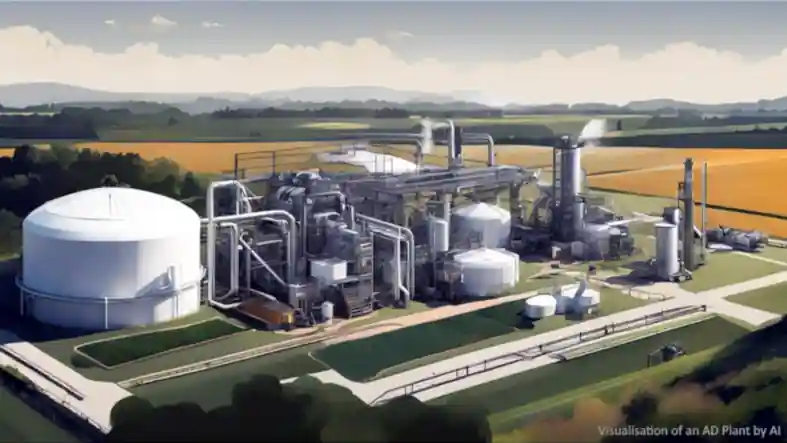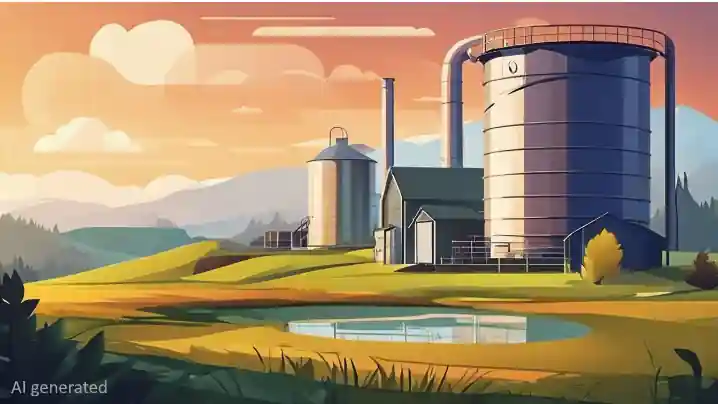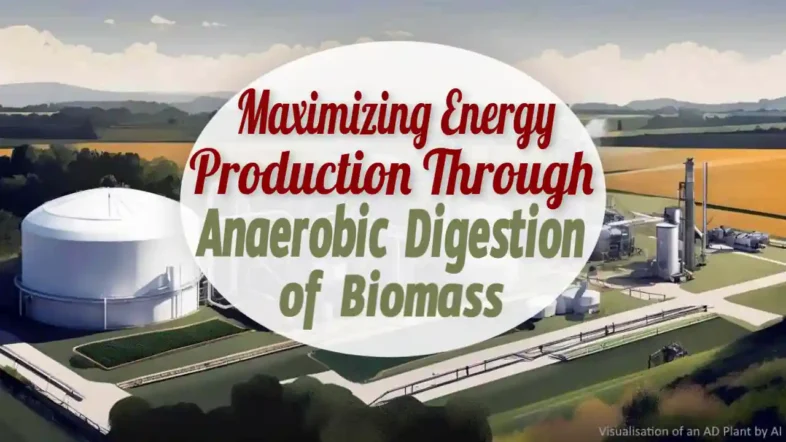All those involved in anaerobic biomass digestion seek the maximum energy production from it that ca be achieved, so we thought that we would write this article. We hope that by reading this we will help you to carry out your anaerobic digestion of biomass more productively.

As the world seeks greener energy, many are turning to organic waste as a solution. Anaerobic digestion transforms this waste into valuable biogas, harnessing energy that once lay dormant in landfills.
This article explores how we can boost energy production through this clever process, making the most of biomass materials around us. Keep reading to discover an eco-friendly powerhouse hidden in plain sight.
Key Takeaways
- Anaerobic digestion is a natural process where microbes turn organic waste, like food scraps and animal poo, into biogas without oxygen. This creates renewable energy.
- There are two kinds of anaerobic digestion: mesophilic happens at moderate temperatures while thermophilic needs more heat but makes more gas.
- By picking the right waste mix (feedstock) and keeping the right moisture level, we can get more biogas out of the process.
- Using digestate left from anaerobic digestion as fertiliser keeps soil healthy and reduces pollution.
- Generating power from biogas helps cut down on greenhouse gases and dependency on fossil fuels. It can even power cars!
Understanding Biomass and Anaerobic Digestion

Anaerobic digestion is a natural process where microorganisms break down organic materials in the absence of oxygen, producing biogas as a byproduct. There are two main types of anaerobic digestion: mesophilic, which occurs at moderate temperatures, and thermophilic, which occurs at higher temperatures.
Anaerobic Digestion Process
Tiny creatures called bacteria work hard in anaerobic digestion. They eat up organic matter like food waste and animal poo without any oxygen around. These tiny workers are great at their job, turning the waste into biogas.
This gas is a mix of methane and carbon dioxide.
We can grab this biogas and use it to make electricity or heat homes. It's pretty cool because it's like recycling trash into energy! Plus, after these bacteria are done, what’s left over can help plants grow as a type of natural fertiliser.
Types of Anaerobic Digestion: Mesophilic and Thermophilic
Anaerobic digestion comes in two types: mesophilic and thermophilic. Mesophilic systems run at cooler temperatures, usually between 30 to 40 degrees Celsius. They are popular, with nine out of ten digesters using this method.
It's a stable process that breaks down biowaste like animal manure into methane.
Thermophilic digestion works at higher temperatures, ranging from 50 to 70 degrees Celsius. This heat-loving system can pump out more biogas than mesophilic systems. The extra warmth speeds up the breakdown of tough materials found in biomass and kills pathogens more effectively, offering a cleaner end product for use as fertiliser or soil conditioner.
Maximising Energy Production

Maximising energy production through anaerobic digestion of biomass involves understanding the importance of feedstocks, managing moisture content, and optimising substrate composition to enhance biogas production.
These factors play a crucial role in maximising the efficiency and output of anaerobic digestion processes.
Importance of Feedstocks
Choosing the right feedstock is key to successful anaerobic digestion. Different materials produce varying amounts of biogas. Energy-packed feedstocks mixed with animal waste boost gas output.
This combo gives better nutrient levels for bacteria during digestion.
Good feedstock choice means more energy and higher-quality biogas. The type of material affects how well the process goes and what kind of biogas you get. So, picking your feedstock wisely is a big deal in getting lots of clean energy from biomass.
Effect of Moisture Content
Selecting the right feedstock is crucial, but so is managing its moisture content. High moisture levels in biomass help microbes break it down during anaerobic digestion. These tiny creatures thrive in wet environments, speeding up the conversion to methane gas.
Dry biomass doesn't work as well because it lacks enough water for bacteria to do their job.
Balancing water content takes careful planning. Too much liquid and the system might get clogged or run too slowly. It's a delicate dance to make sure there's just enough moisture for maximum energy output from each batch of biomass going through digestion.
Keep things not too dry nor too wet, and you will harness more renewable energy efficiently.
Role of Substrate Composition
The makeup of the material we feed into anaerobic digesters is key to how much energy we can get out. If there's a lot of lignin, it's tougher for microbes to break down the biomass, which means less methane gas in the end.
Mixing different types of wastes, like putting food scraps together with cow poo, helps a bunch. It keeps costs down and boosts energy output.
We see more biogas when we pick smart combinations for co-digestion. Stuff like fruit peels and veggie leftovers mix well with animal waste. Together, they provide a balanced diet for the bacteria inside digesters that make methane gas.
This mixed-menu approach is becoming popular because it works so well at making more clean energy from our leftovers and dung.
Applications of Anaerobic Digestion
Anaerobic digestion has a wide range of applications, including waste and wastewater treatment, power generation, vehicle fuel production, and the production of fertiliser and soil conditioner.
These applications contribute to sustainable solutions for managing organic waste while also generating renewable energy.
Waste and Wastewater Treatment
Waste and wastewater carry loads of organic matter that we can turn into energy. Anaerobic digestion steps in to transform this waste into useful products like biogas. This process keeps waste out of landfills.
It also cuts down on greenhouse gases since the methane produced is used for energy instead of escaping into the air.
Treating wastewater with anaerobic digestion makes a lot of sense for cities too. It uses bacteria to break down solids in water, creating cleaner water and renewable energy at the same time.
Plants can then release the treated water back into rivers without harming the environment or they can use it for farming.
Power Generation
The biogas from the anaerobic digestion process turns waste into power. This gas mainly contains methane, similar to natural gas used in homes and industries. By burning biogas in engines, we produce electricity and heat.
These engines connect to generators that make the electricity.
The beauty of this process is its twofold impact: it cuts greenhouse gas emissions and creates energy sustainably. Electricity generated this way can feed into the national grid or power local facilities.
It helps communities become less reliant on fossil fuels and contributes to a cleaner environment.
Vehicle Fuel Production
Anaerobic digestion of biomass offers a sustainable solution for vehicle fuel production. The biogas produced, rich in methane, can be upgraded and compressed and then harnessed as a renewable energy resource to power road vehicles.
This not only supports waste management practices but also reduces our reliance on fossil fuels, contributing to environmental sustainability and climate balance.
Biomethane is the name of the pure methane gas generated through anaerobic digestion and the resulting production of biogas. Biomethane is a clean and sustainable alternative to non-renewable vehicle fuels made from natural gas and oil. It contributes to reducing greenhouse gas emissions while promoting the use of renewable natural gas (RNG) in transportation.
Fertiliser and Soil Conditioner
Anaerobic digestion of biomass produces digestate, a nutrient-rich organic by-product containing essential elements like nitrogen, phosphorus, and potassium. This digestate acts as an effective soil conditioner and fertiliser, enhancing soil fertility and structure.
Application of digestate aids in reviving degraded areas owing to its abundance of vital nutrients and organic matter, contributing to sustainable soil management practices. The integration of anaerobic digestion with biomass production not only maximises energy production through biogas generation but also offers a valuable contribution to sustainable soil management.
By leveraging the resources generated from anaerobic digestion processes, waste management professionals can enhance renewable energy production while promoting better land use practices.
Outputs of Anaerobic Digestion
The outputs of anaerobic digestion include biogas, which can be used for power generation or vehicle fuel production. Additionally, digestate and wastewater are also produced as by-products of the process.
Biogas
Biogas, primarily made of methane (CH4), is a renewable energy source derived from the controlled anaerobic digestion of organic matter. The production process involves breaking down materials like food waste under oxygen-free conditions.
This environmentally friendly fuel has significant potential for generating electricity, heating, and powering vehicles while reducing greenhouse gas emissions and dependence on conventional fuels such as natural gas.
Notably, a large-scale anaerobic digestion plant processing 100 tons of food waste daily can produce enough biogas to provide annual power for 800 to 1,400 homes.
Digestate
Digestate, a key product of anaerobic digestion, comprises high levels of water and organic material. This valuable by-product can be further processed for optimal use as a renewable energy source.
By undergoing treatments like drying, digestate‘s potential is maximised to contribute to sustainable energy production. Additionally, anaerobic digestion decreases environmental impact by offering digestate as an alternative to chemical fertilisers, thus fostering a more eco-friendly approach in the realm of waste management and energy generation.
Anaerobic digestion yields digestate with significant water and organic matter content, which can be treated for maximum potential as a renewable energy source. Through processes such as drying, the value of digestate can be optimised towards contributing to sustainable energy production while reducing reliance on chemical fertilisers.
Wastewater from Industrial Effluent Treatment Processes
Moving from digestate, now let's focus on wastewater treatment using the anaerobic digestion process. Anaerobic digestion of biomass offers an effective solution for managing
- high-strength (CSTRS – big digester tanks) to
- low-strength organic wastes (anaerobic treatment columns and Upflow anaerobic sludge blanket technology also known as UASB reactor filters),
- including those derived from commercial, and industrial sources.
Studies have revealed the potential of anaerobic digestion in producing biomethane specifically from wastewater-irrigated biomass, addressing both waste management challenges and energy production needs.
Advantages of Anaerobic Digestion of Biomass
Anaerobic digestion of biomass offers numerous benefits, including the reduction of pollution, commercial advantages for businesses, meeting legal and political objectives, and addressing the growing demand for alternative energy sources.
Reduction of Pollution
Anaerobic digestion of biomass plays a crucial role in reducing pollution by preventing the release of methane, minimising air and water pollution, and degrading organic matter in waste.
This process significantly reduces odours compared to typical storage and land application of manures, making it an effective method for environmental researchers, waste management professionals, and government officials to consider when addressing pollution concerns.
In addition to its reduction of odours compared to traditional methods of handling manure, anaerobic digestion can also help prevent the release of methane – a potent greenhouse gas that contributes to global warming.
Commercial Benefits
Anaerobic digestion of biomass offers significant commercial benefits. It enables the recovery of surplus energy as electricity and heat, reducing reliance on energy imports. The process also leads to cost savings by utilising waste by-products for energy generation, thus lowering waste disposal costs significantly.
Furthermore, anaerobic digestion produces valuable biofertilisers, contributing to additional revenue streams while also providing an eco-friendly alternative for waste management.
The technology aligns with legal and political objectives focusing on environmental sustainability, thereby positioning businesses favourably in compliance with regulatory frameworks.
Legal and Political Objectives
Regulatory frameworks and incentives play a crucial role in promoting the use of anaerobic digestion technology for energy production. Biomass policy statements have been established to regulate certain uses of biomass that impact air quality, aligning with legal and political objectives.
These objectives are deeply linked to maximising energy production through the anaerobic digestion of biomass, reflecting the importance placed on sustainable and environmentally friendly energy sources by governments worldwide.
These legal and political initiatives act as catalysts in driving the adoption of anaerobic digestion technology, encouraging research, investment, and implementation within the waste management sector.
They reflect a commitment to harnessing renewable resources while minimising negative environmental impacts from traditional waste management practices.
Demand for Alternative Energy Sources
The demand for alternative energy sources is steadily increasing due to the need for sustainable and eco-friendly solutions. Anaerobic digestion provides a viable option by efficiently converting organic waste into biogas, offering a renewable energy source that can be used for electricity, heating, and transportation fuel.
This process helps in reducing reliance on traditional fossil fuels while also addressing environmental concerns related to pollution and greenhouse gas emissions. The versatility of anaerobic digestion makes it an attractive choice for meeting the rising demand for clean and renewable energy.
Moving on to “Challenges and Solutions in Anaerobic Digestion”, let's delve deeper into the obstacles faced in implementing this technology.
Challenges and Solutions in Anaerobic Digestion
Managing odour from the anaerobic digester can be a challenge, but using proper ventilation and cover systems can help control it. Complying with waste controls and regulations is essential, and finding alternative uses for animal by-products can also mitigate potential issues.
Managing Odour from the Anaerobic Digester
Odour from the anaerobic digester can be reduced by covering storage tanks and using biofilters. Additionally, installing covers on manure lagoons can help control odours. Remember, proper management of feedstock ratios and moisture levels in the digester can also mitigate odour issues.
Odour reduction is vital to address community concerns and ensure compliance with environmental regulations.
Considering that foul odours are a common issue associated with anaerobic digestion, it's crucial to implement effective strategies to manage these unpleasant smells. This involves utilising technologies such as biofiltration and tank covering while maintaining optimal feedstock ratios and moisture levels within the system.
Complying with Waste Controls
To streamline the process of maximising energy production through anaerobic digestion of biomass, efficient food waste collection is paramount to complying with waste controls. Co-digestion of organic waste and biomass can optimise anaerobic digestion efficiency while aligning with waste control regulations.
Traditional methods such as composting and anaerobic digestion are effective in treating organic waste, with the latter providing an added benefit of biogas production, thus facilitating compliance with waste controls and enhancing sustainability efforts.
Anaerobic digestion facilities play a crucial role in managing organic waste while adhering to environmental regulations. The co-digestion approach enables diverse feedstocks to be effectively utilised for energy generation, ensuring compliance with stringent waste control measures.
Dealing with Animal By-Products
Anaerobic digestion can result in nutrient-rich digestate from animal manure, posing challenges due to the high nitrogen concentration. Controlled anaerobic digestion of animal manure is crucial to reduce foul odour production and environmental impact.
Careful management of digestate is essential for minimising environmental impacts, especially with regard to the nutrient-rich nature of animal by-products used for land spreading and as fertiliser. In the UK and Europe, the Animal Byproducts Regulations require special precautions to prevent waste that may contain animal by-products from infecting animals. Biogas plants that accept food waste are classified as animal by-product waste and special requirements apply.
Moving on from dealing with animal by-products, it's important to understand the applications of anaerobic digestion and its significance in waste and wastewater treatment.
Addressing Community Issues
Dealing with animal by-products ensures efficient waste management, but addressing community issues is crucial for the successful implementation of anaerobic digestion projects. Understanding and involving the local community in decision-making processes can reduce resistance, create a sense of ownership, and increase acceptance of such facilities as part of sustainable waste management practices.
It is important to communicate the benefits clearly and address any concerns related to odour, noise, traffic impacts, and potential property devaluation in neighbourhoods near proposed AD facilities.
Building trust through transparency and open dialogue with citizens can help mitigate these challenges before they escalate.
Local stakeholders play a vital role in shaping the success of anaerobic digestion projects by providing valuable insights into specific environmental concerns that are pertinent to their communities.
Engaging with residents from an early stage allows for collaborative problem-solving that aligns project outcomes with broader community development objectives while ensuring environmental sustainability remains at the forefront.
Conclusion
In conclusion, anaerobic digestion offers a sustainable solution for maximising energy production from biomass. It provides significant environmental and economic benefits by converting organic waste into clean renewable energy.
The process plays a crucial role in reducing pollution, meeting commercial objectives, and fulfilling the demand for alternative energy sources. By understanding the importance of feedstocks, moisture content, and substrate composition, we can optimise anaerobic digestion to meet the growing need for bioenergy.
Incorporating anaerobic digestion into waste management and energy production practices can contribute to a more sustainable future.
FAQs
1. What is anaerobic digestion of biomass?
Anaerobic digestion of biomass is a process where microorganisms break down organic materials like crop residues and waste without oxygen, producing biogas.
2. How does this process help in energy production?
The process converts the biodegradable part of waste into biogas, which can be used as a renewable energy source or put into the natural gas grid.
3. Can this method reduce harmful emissions?
Yes, by digesting organic matter anaerobically instead of through waste incineration, we produce fewer carbon dioxide and hydrogen sulfide, helping to decarbonise our environment.
4. What are the benefits of using solid-state fermentation for digestion?
Solid-state fermentation allows high solids content like grasses and woods to be digested efficiently in fermenter boxes leading to higher methane production over time.
5. Is it possible to use all types of plant material in this process?
Most plant materials including crop residues, fruit and vegetable wastes, woods and seaweed can be used; however, their methane potential may vary depending on their digestion characteristics.
6. Besides making energy, what else do we get from anaerobic digestion?
After extracting bio-methane for fuel uses such as Combined Heat and Power Plants or upgrading for grid injection; a nutrient-rich soil improver known as humus that improves soil structure can also be produced from the remaining digestate.



